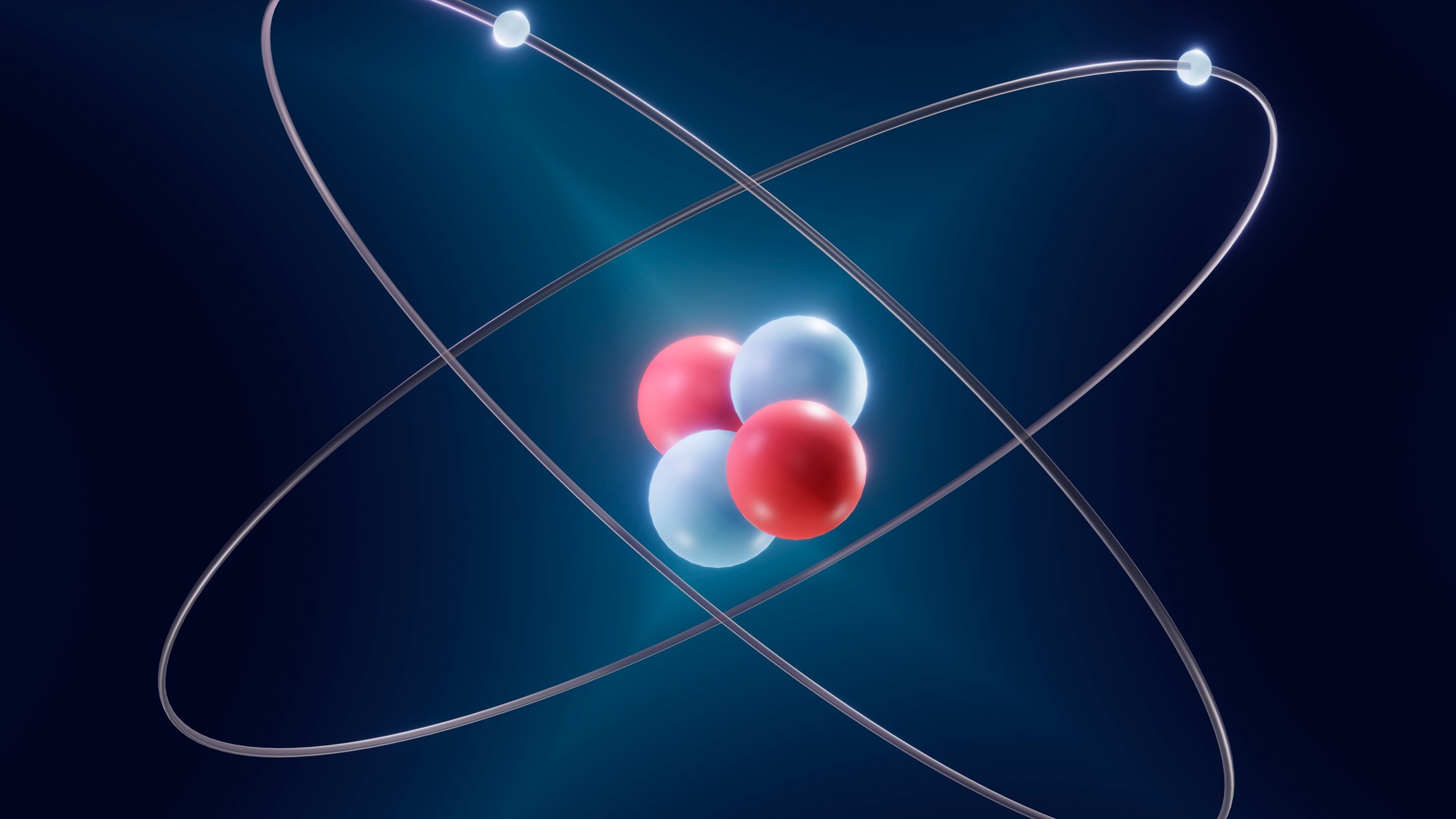Scientists tried to solve the mystery of the helium nucleus — and ended up more confused than ever
Helium is the simplest element in the periodic table with more than one particle in its nucleus, yet state of the art theory and experiments on it don't add up.

One of nature's simplest elements is giving scientists a big headache after new research shows that protons and neutrons in helium atoms are not behaving as theory suggests they should. The mismatch between theoretical predictions of how these particles behave and what they're actually doing could point to new physics beyond the Standard Model, the reigning model that describes the zoo of subatomic particles.
In research published in April in the journal Physical Review Letters, physicists zapped a container of helium atoms with electrons to knock the helium nuclei into an excited state, causing the nucleus to temporarily swell up and deflate, like a chest breathing. The team found that the response of the protons and neutrons in the nucleus to the electron beam diverged significantly from what theory predicts — confirming conclusions drawn from experiments done decades ago. The new research proves that this mismatch is real, not an artifact of experimental uncertainty. Instead, it seems scientists simply do not have a firm enough grasp of the low-energy physics that govern interactions between the particles in the nucleus.
The helium nucleus comprises two protons and two neutrons. The equations describing the behavior of the helium nucleus are used for all kinds of nuclear and neutron matter, so resolving the discrepancy could help us understand other exotic phenomena, such as the mergers of neutron stars.
The discrepancy between theory and experiment first became evident in 2013 following calculations of the helium nucleus led by Sonia Bacca, then at Canada's national TRIUMF particle accelerator and now a professor at Johannes Gutenberg University Mainz, and co-author of the new study. Bacca and colleagues used upgraded techniques to calculate how the protons and neutrons in a helium nucleus behave when excited by a beam of electrons, which yielded figures that diverged significantly from the experimental data. However, the experimental data used for comparison dated back to the 1980s and was recorded with large uncertainties in the measurements.
The new study's lead author Simon Kegel, a nuclear physicist who studied the helium nucleus for his doctoral dissertation at Johannes Gutenberg University Mainz, in Germany, pointed out that the current facilities at his university could perform these measurements with very high precision. "We thought, if you can do that a little better we should at least try," he told Live Science.
Better but worse
The primary interaction holding the particles in the nucleus together is called the strong force — but a cornucopia of effects that stem from nuances of these interactions complicate calculations of how these particles interact. Theoreticians had simplified the problem using "effective field theory" (EFT), which approximates the many forces acting on the particles, just like a jpeg file approximates all the data in an uncompressed image file. The upgraded version of EFT gives a better approximation of the effects that complicate models of the strong interactions in the nucleus, yet when the researchers crunched the numbers, they found the theoretical predictions veered even further away from observed phenomena than the cruder approximations did.
To check how much of the discrepancy could be attributed to experimental uncertainty, Kegel and the Mainz team used the MAMI electron accelerator facility at the University to shoot a beam of electrons at a container of helium atoms. The electrons knock the helium nuclei into an excited state described as an isoscalar monopole. "Imagine the nucleus like a sphere which changes its radius, swelling and shrinking, keeping the spherical symmetry," Bacca, told Live Science by email.
Sign up for the Live Science daily newsletter now
Get the world’s most fascinating discoveries delivered straight to your inbox.
Two parameters improved the precision of the measurements — the density of the helium atoms in the container and the intensity of the beam of low-energy electrons. Both could be dialled to very high values at the University Mainz facility, Kegel said.
Before they had even finished analyzing the data it was clear that this new data set was not going to resolve the issue. Scientists still don't know the source of the discrepancy between theory and experiment. But Bacca suggested that "missing or not well-calibrated pieces of the interactions," may be the cause.
Once the new Mainz Energy-recovering Superconducting Accelerator (MESA) goes online in 2024, it will produce electron-beams of orders of magnitude larger intensity than the current accelerator, although still at the low energies required for this kind of experiment. This contrasts with the accelerators like the Large Hadron Collider, vying for higher energy beams to discover exotic new particles at the other end of the energetic spectrum. Nonetheless the higher intensities of MESA will allow even higher precision measurements, and an even more detailed view of the low-energy frontier of the Standard Model.

Anna Demming is a freelance science journalist and editor. She has a PhD from King’s College London in physics, specifically nanophotonics and how light interacts with the very small. She began her editorial career working for Nature Publishing Group in Tokyo in 2006. She has since worked as an editor for Physics World and New Scientist. Publications she has contributed to on a freelance basis include The Guardian, New Scientist, Chemistry World, and Physics World, among others. She loves all science generally, but particularly materials science and physics, such as quantum physics and condensed matter.










